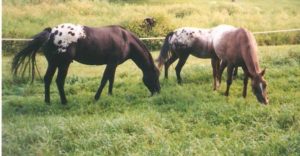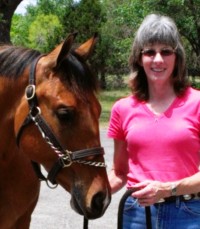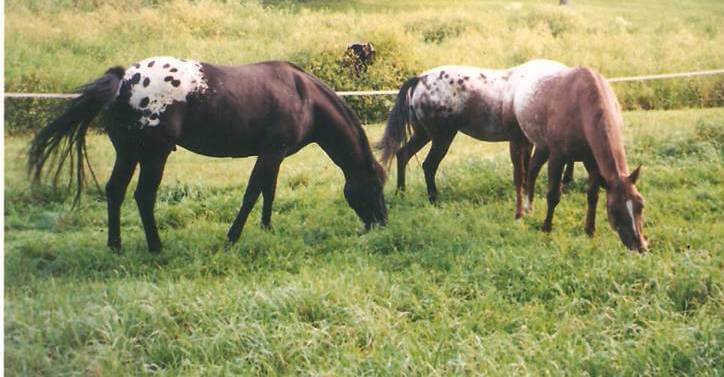Preventing Digestive Upset Means Horses Need Continuous Fiber
By Eleanor Blazer
It’s feeding time and the horses know it. Feed buckets are rattling; there are nickers and the banging of hooves against gates.
In most stables the concentrate or “grain” is given first––to satisfy the immediate need and calm the stable. Even if hay is given simultaneously the concentrate will be eaten first. But is that wise?
First, we need to understand some basic facts regarding the equine digestive system. Horses are designed to utilize forage; they are animals that graze––requiring a constant trickle of long-stem fiber moving through the digestive system.
The chewing of forage produces saliva which helps buffer the production of acid in the stomach. A horse with access to adequate amounts of forage will produce five to ten gallons of saliva a day. The more he chews the more buffering agent he introduces into the stomach. The bulky mixture of forage and saliva helps protect the delicate lining of the upper stomach region from the acid. Without this protection gastric ulcers can form. Studies have shown lesions can occur in less than 12 hours if stomach acid is not kept at bay.
In order to get the protection long-stem fiber and saliva provides against ulcers, an adequate amount of forage must be fed at least an hour before the grain or concentrate portion of the meal. Tossing in a flake of hay and then feeding grain 10 minutes later is not going to be of any benefit. Plus, the horse will probably not eat the hay as he knows the grain is coming in a few minutes.
After the feed leaves the stomach it enters the small intestine. This is where starch, complex sugars, protein from the grain portion of the diet, fat, fat-soluble vitamins (A, D, and E), and most minerals are utilized…and then it is on to the large intestine where the remaining material enters the cecum.
The cecum is a fermentation vat. Within the cecum are microbes and bacteria that aid in the digestion of cellulose and fiber.
If excessive amounts of starch and complex sugars reach the cecum (instead of being utilized in the small intestine) a condition known as cecal acidosis can occur. The starch and sugar accelerates the fermentation process leading to a high acidic level. The acid kills the beneficial bacteria and microbes which creates a toxic environment, resulting in diarrhea, colic and possibly laminitis.
We do not want this to happen.
Feeding high starch grain or concentrates on an empty stomach will allow it to move through the equine digestive system quickly––possibly reaching the cecum before becoming fully digested in the small intestine. The presence of fiber (forage) will slow this movement.
Management and choice of feed can lessen the chance of horses developing gastric ulcers or cecal acidosis, or both.

In a perfect world our horses would be allowed to roam and graze––as nature intended. But few domestic horses have that option. The alternative is to allow plenty of turn-out time with access to free-choice long-stem forage (hay) and offer a low-starch concentrate that provides the nutrients that are lacking in the forage.
Feeding schedules should be small frequent meals in a 24-hour period, instead of two large meals in the morning and late afternoon. Many stables feed the evening meal around 5 pm and the next meal not until morning. This guarantees an empty stomach and digestive tract by breakfast unless an adequate amount of forage was provided the evening before. The use of slow hay feeders or nets can assist in making the forage meal last longer.
Purchase one of the low-starch feed formulas on the market. These products are nutritionally balanced and are safer than high grain mixes. Find a product designed for the age, health and activity level of your horse, then feed according to the directions…this means feed by the pound, not by the scoop. Every feed room should have a scale––and remember to make all feed changes gradually when introducing a new feed.
Horses are creatures of habit. They also have very sensitive digestive systems. It is our responsibility to ensure they are fed in the healthiest manner possible.
Copyright 2018 The Way of Horses
* Earn a Bachelor of Science Degree in Equine Studies or certification as a Professional Horse Trainer or Riding Instructor. Start your new career as a riding instructor, horse trainer, or stable manager. All courses are online. Visit www.horsecoursesonline.com for information.

Eleanor Blazer was raised training and caring for horses. She learned to ride and care for the horses her family bought and sold. Many of these horses required improved nutrition when they arrived for training. Eleanor’s experience and research has benefited both horses and horse lovers in the field of equine nutrition. An equine nutrition consultant, based in Bulverde, Texas, she keeps busy doing equine nutrition consultations, conducting seminars, and speaking to youth groups about horse care and nutrition. Eleanor is the author of the syndicated column The Way of Horses. She has more than 20 years experience helping and being a mentor to those wanting to know how to provide the very best care and nutrition for our special friend – the horse.






